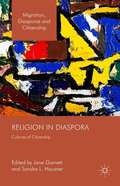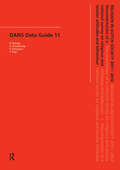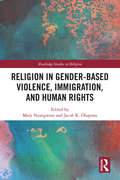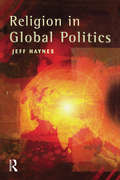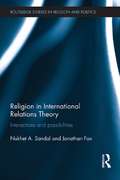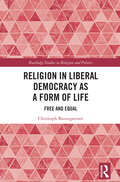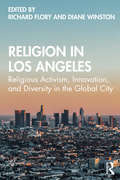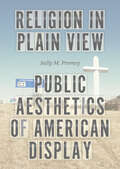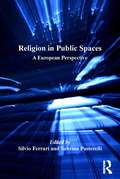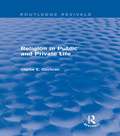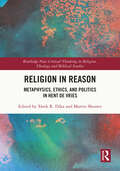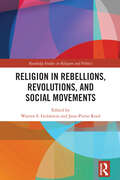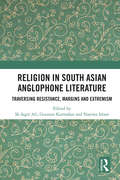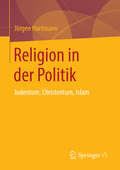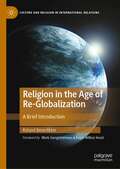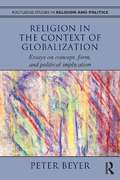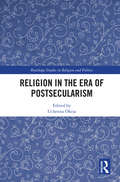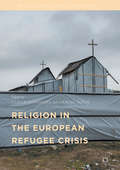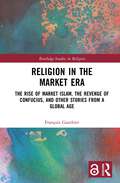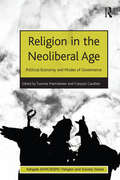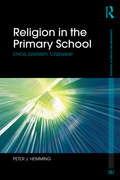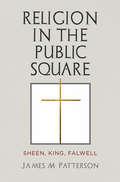- Table View
- List View
Religion in Diaspora: Cultures of Citizenship (Migration, Diasporas and Citizenship)
by Sondra L. Hausner Jane GarnettThis edited collection addresses the relationship between diaspora, religion and the politics of identity in the modern world. It illuminates religious understandings of citizenship, association and civil society, and situates them historically within diverse cultures of memory and state traditions.
Religion in Dutch Society 2011-2012: Documentation of a national survey on religious and secular attitudes and behaviour in 2011-2012 (DANS Publications)
by R. Eisinga P. Scheepers G. Kraaykamp P. ThijsThis Data Guide provides the documentation of a national survey on religious and secular attitudes and behaviour in Dutch society 2011-2012. The data files as well as additional documentation files of this publication can be downloaded from the online archiving system EASY of Data Archiving and Networked Services (DANS). DANS promotes sustained access to digital research data. For this purpose, DANS encourages scientific researchers to archive and reuse data in a sustained manner, e.g. by means of the online archiving system EASY. DANS also provides access, through NARCIS, to thousands of scientific datasets, e-publications and other research information in the Netherlands. In addition, the institute provides training and advice and performs research into sustained access to digital information. Driven by data, DANS ensures that access to digital research data keeps improving, by its services and by taking part in (international) projects and networks. Please visit www.dans.knaw.nl for more information and contact details. DANS is an institute of the Royal Netherlands Academy of Arts and Sciences (KNAW) and the Netherlands Organisation for Scientific Research (NWO).
Religion in Gender-Based Violence, Immigration, and Human Rights (Routledge Studies in Religion)
by Jacob K. Olupona Mary NyangwesoThis book builds on work that examines the interactions between immigration and gender-based violence, to explore how both the justification and condemnation of violence in the name of religion further complicates our societal relationships. Violence has been described as a universal challenge that is rooted in the social formation process. As humans seek to exert power on the other, conflict occurs. Gender based violence, immigration, and religious values have often intersected where patriarchy-based power is exerted on the other. An international panel of contributors take a multidisciplinary approach to investigating three central themes. Firstly, the intersection between religion, immigration, domestic violence, and human rights. Secondly, the possibility of collaboration between various social units for the protection of immigrants’ human rights. Finally, the need to integrate faith-based initiatives and religious leaders into efforts to transform attitude formation and general social behavior. This is a wide-ranging and multi-layered examination of the role of religion in gender-based violence and immigration. As such, it will be of keen interest to academics working in religious studies, gender studies, politics, and ethics.
Religion in Global Health and Development: The Case of Twentieth-Century Ghana
by Benjamin Bronnert WalkerThe COVID-19 pandemic has made evident that the field of global health – its practices, norms, and failures – has the power to shape the lives of billions. Global health perspectives on the role of religion, however, are strikingly limited. Uncovering the points where religion and global health have connected across the twentieth century, focusing on Ghana, provides an opportunity to challenge narrow approaches.In Religion in Global Health and Development Benjamin Walker shows that the religious features of colonial state architecture were still operating by the turn of the twenty-first century. Walker surveys the establishment of colonial development projects in the twentieth century, with a focus on the period between 1940 and 1990. Crossing the colonial-postcolonial divide, analyzing local contexts in conjunction with the many layers of international organizations, and identifying surprisingly neglected streams of personnel and funding (particularly from Dutch and West German Catholics), this in-depth history offers new ways of conceptualizing global health.Patchworks of international humanitarian intervention, fragmented government services, local communities, and the actions of many foreign powers combined to create health services and the state in Ghana. Religion in Global Health and Development shows that religion and religious actors were critical to this process – socially, culturally, and politically.
Religion in Global Politics
by Jeff HaynesOne of the most resilient ideas about societal development after World War II was that nations would inevitably secularise as they modernised. However, as we come to the end of the 'secular' twentieth century, it is obvious that religion continues to be an important factor in politics around the world. The author examines the continuing importance of religion, focusing upon the regions of Europe, the Americas, Africa, and Asia.
Religion in International Relations Theory: Interactions and Possibilities (Routledge Studies in Religion and Politics)
by Jonathan Fox Nukhet SandalThere is a growing realization among international relations scholars and practitioners that religion is a critical factor in global politics. The Iranian Revolution, the September 11 attacks, the ethno-religious conflicts such as the ones in the former Yugoslavia and Sri Lanka are among the many reasons for this increased focus on religion in international affairs. The rise of religious political parties across the world ranging from the Christian Democrats in Europe to Bharatiya Janata Party in India similarly illustrated religion's heightened international profile. Despite all this attention, it is challenging to situate religion within a discipline which has been dominantly secular from its inception. Only a few existent works have ventured to integrate religion into core international relations theories such as Classical Realism, Neorealism, Neoliberalism, Constructivism and the English school. This work is the first systematic attempt to comparatively assess the place of religion in the aforementioned theoretical strands of international relations with contemporary examples from around the world. Written in an accessible and systematic fashion, this book will be an important addition to the fields of both religion and international relations. Nukhet A. Sandal is Assistant Professor in the Political Science Department at Ohio University. Jonathan Fox is Professor in the Department of Political Studies at Bar Ilan University, Israel.
Religion in Liberal Democracy as a Form of Life: Free and Equal (Routledge Studies in Religion and Politics)
by Christoph BaumgartnerReligion in Liberal Democracy as a Form of Life advances a theory to deal with the challenges connected to the liberal democratic ideal that all people are free to codetermine the future of their society and equally entitled to their religion and beliefs, given the historical bias towards Christianity in politics and culture within many European societies.Religious diversity and social and political participation are in fact fiercely contested issues. Critical scholars from philosophy and cultural theory contest that liberal political theories of freedom of religion can adequately deal with issues connected to an increasingly diversified and secularized religious field in historically Christian societies. Consequently, they claim that politics based on such theories cannot deliver on the promise to ensure conditions that allow all members of society equal religious freedom and political participation. By outlining historical developments, and by closely examining case studies of recent controversies about religious diversity in Germany and the Netherlands, this book identifies shortcomings of the currently predominant liberal account of freedom of religion or belief. Based on this analysis, the author proposes a more complex theory of liberal democracy as a form of life, with religion and religious freedom as components of it. This takes into account that informal norms, social structures, and predominant notions of belonging can function as powerful obstacles to freedom and equality, even if formal legal and political institutions prohibit discrimination based on religion. Construing liberal democracy as a “form of life”—that is, as a set of social practices, attitudes, and their institutional manifestations and material expressions—shifts the focus of critical analysis from the law to informal structures and components. This provides an understanding of the dynamics of (culturalized) religion in society, which has often been missing in political philosophical theories. The theory proposed in this book provides normative criteria for building liberal democracies that are tolerant with respect to religious differences and solidaric in terms of ensuring conditions that allow all members of society to codetermine, as equals, the future of society, irrespective of their religion or beliefs.This book will appeal to scholars of political theory, social and political philosophy, religious studies, sociology, and anthropology.
Religion in Los Angeles: Religious Activism, Innovation, and Diversity in the Global City
by Richard FloryWhy has Los Angeles been a hotspot for religious activism, innovation, and diversity? What makes this Southern California metropolis conducive to spiritual experimentation and new ways of believing and belonging? A center of world religions, Los Angeles is the birthplace of Pentecostalism, the site of the largest Roman Catholic diocese in the United States, the home of more Buddhists anywhere except for Asia, and home base for myriad transnational, spiritual movements. Religion in Los Angeles examines historical and contemporary examples of Angelenos’ openness to new forms of belief and practice in congregations, communities, and civic life. Case studies include Latino spiritualities and social activism Hybrid Jewish identities Capitalism and fundamentalism in early twentieth-century Los Angeles The impact of the 1960s on Roman Catholic Angelenos Christianity through a Hindu lens. Highlighted throughout the work are themes including the impact of the city’s diversity on religious experimentation, the importance of Los Angeles’ location in relation to the Mexican border and as a gateway to the Pacific, and the impact of local politics, social trends, and cultural change on religious innovation. The volume also examines the creative pull between change and continuity and the recognition that religious communities participate in civic and global conversations. Religion in Los Angeles includes contributions by leading sociologists, anthropologists, and historians. This cutting-edge work will be of interest to students and scholars of religious history, religion in America, sociology of religion, American studies, urban studies, and race/ethnic studies.
Religion in Plain View: Public Aesthetics of American Display
by Sally M. PromeyA revelatory critique of public display in the United States. In Religion in Plain View, Sally M. Promey analyzes religion’s visible saturation of American public space and the histories that shaped this exhibitionary aesthetics. In street art, vehicle décor, signs, monuments, architecture, zoning policy, and more, Promey exposes American display’s merger of evangelicalism, capitalism, and imperialism. From this convergence, display materializes a distinctly American drive to advertise, claim territory, invalidate competitors, and fabricate a tractable national heritage. Charting this aesthetics’ strategic work as a Protestant technology of White nation formation, Religion in Plain View offers a dynamic critique of the ways public display perpetuates deeply ingrained assumptions about the proper shape of life and land in the United States.
Religion in Public Spaces: A European Perspective (Cultural Diversity and Law in Association with RELIGARE)
by Silvio FerrariThis timely volume discusses the much debated and controversial subject of the presence of religion in the public sphere. The book is divided in three sections. In the first the public/private distinction is studied mainly from a theoretical point of view, through the contributions of lawyers, philosophers and sociologists. In the following sections their proposals are tested through the analysis of two case studies, religious dress codes and places of worship. These sections include discussions on some of the most controversial recent cases from around Europe with contributions from some of the leading experts in the area of law and religion. Covering a range of very different European countries including Turkey, the UK, Italy and Bulgaria, the book uses comparative case studies to illustrate how practice varies significantly even within Europe. It reveals how familiarization with religious and philosophical diversity in Europe should lead to the modification of legal frameworks historically designed to accommodate majority religions. This in turn should give rise to recognition of new groups and communities and eventually, a more adequate response to the plurality of religions and beliefs in European society.
Religion in Public and Private Life (Routledge Revivals)
by Clarke E. CochranReligious crosses the spheres of both the private life and the public institution. In a liberal democracy, public and private interests and goals prove to be inseparable. Clarke Cochran’s interdisciplinary study brings political theory and the sociology of religion together in a fresh interpretation of liberal culture. First published in 1990, this analysis begins with a reassessment of the nature of the "public" and the "private" in relation to the political. The controversy over religion and politics is examined in light of such contested issues of political life as sexuality, abortion, and the changing nature of the family. Clarifying a number of debates central to contemporary society, this timely reissue will be of particular value to students with an interest in the relationship between religious, society, and politics.
Religion in Reason: Metaphysics, Ethics, and Politics in Hent de Vries (Routledge New Critical Thinking in Religion, Theology and Biblical Studies)
by Martin Shuster Tarek R. DikaThis book presents critical engagements with the work of Hent de Vries, widely regarded as one of the most important living philosophers of religion. Contributions by a distinguished group of scholars discuss the role played by religion in philosophy; the emergence and possibilities of the category of religion; and the relation between religion and violence, secularism, and sovereignty. Together, they provide a synoptic view of how de Vries’s work has prompted a reconceptualization of how religion should be studied, especially in relation to theology, politics, and new media. The volume will be of particular interest to scholars of religious studies, theology, and philosophy.
Religion in Rebellions, Revolutions, and Social Movements (Routledge Studies in Religion and Politics)
by Warren S. Goldstein Jean-Pierre ReedReligion in Rebellions, Revolutions, and Social Movements demonstrates that, while religion is often a social force that maintains, if not legitimates, the socio-political order, it is also a decisive factor in economic, social, and political conflict. The book explores how and under what conditions religion functions as a progressive and/or reactionary force that compels people to challenge or protect social orders. The authors focus on the role that religion has played in peasant, slave, and plebeian rebellions; revolutions including the Chinese, English, French, Russian, and Iranian; and modern social movements. In addition to these case studies, the book also contains theoretical chapters which explore the relationship religious thought has with the politics of liberation and oppression. It examines the institutional, organizational, ritualistic, discursive, ideological, and/or framing mechanisms that give religion its oppressive and liberating structures. Many scholars of religion continue very conventional modes of thinking, ignoring how religion has been—and continues to be—both a hegemonic and counter-hegemonic force in conflict. This book looks at both sides of the equation. This international and interdisciplinary volume will interest students and scholars in the fields of politics of religion, sociology of religion, religious studies, gender studies, and history.
Religion in South Asian Anglophone Literature: Traversing Resistance, Margins and Extremism
by Goutam Karmakar Nasima Islam Sk Sagir AliThis volume studies the representation of religion in South Asian Anglophone literature of the twentieth and twenty-first century. It traces the contours of South Asian writing through the consequences of the complex contesting forces of blasphemy and secularization. Employing a cross-disciplinary approach, it discusses various key issues such as religious fundamentalism, Islamophobia, religious majoritarianism, nationalism, and secularism. It also provides an account of the reception of this writing within the changing conceptions of racial "Others" and cultural difference, particularly with respect to minority writers, in terms of ethnic background and lack of access to social mobility. The volume features chapters on key texts, including The Hungry Tide, The Enchantress of Florence, In Times of Seige, One Part Woman, Anil’s Ghost, The Book of Gold Leaves, Red Earth and Pouring Rain, The Black Coat and Swarnalata, among others. An important contribution to the study of South Asian literature, the book will be indispensable for students and researchers of literary studies, religious studies, cultural studies, literary criticism, and South Asian studies.
Religion in a Liberal State
by Gavin D'Costa Gavin D'Costa Malcolm Evans Tariq Modood Julian Rivers Malcolm Evans Tariq ModoodAs religion has become more visible in public life, with closer relations of co-operation with government as well as a force in some political campaigns, its place in public life has become more contested. Fudged compromises of the past are giving way to a desire for clear lines and moral principles. This book brings the disciplines of law, sociology, politics and theology into conversation with one anther to shed light on the questions thrown up by 'religion in a liberal state'. It discusses practical problems in a British context, such as the accommodation of religious dress, discrimination against sexual minorities and state support for historic religions; considers legal frameworks of equality and human rights; and elucidates leading ideas of neutrality, pluralism, secularism and public reason. Fundamentally, it asks what it means to be liberal in a world in which religious diversity is becoming more present and more problematic.
Religion in der Politik: Judentum, Christentum, Islam
by Jürgen HartmannDie Politikwissenschaft hat sich des Religionsthemas bislang kaum angenommen. Vielmehr war und ist die Religion in der Sozialwissenschaft ein klassisches Thema der Soziologie (Weber, Durkheim, Berger, Luckmann, Luhmann). Aus einer vergleichenden Perspektive heraus will diese politikwissenschaftliche Analyse Antworten auf folgende Fragen finden: Warum haben die christlichen Konfessionen in Europa an politischer Prägekraft verloren, während sie in den USA noch die politische Sprache prägen und einen Bezugsrahmen für die Artikulierung politischer Interessen darstellen, und aus welchem Grund ist der Islam im orientalisch-asiatischen Raum eine dynamische Kraft in der Politik.
Religion in the Age of Re-Globalization: A Brief Introduction (Culture and Religion in International Relations)
by Roland BenedikterThis book provides a concise introduction into twenty-one trends that are transforming the role of religion and spirituality in “re-globalizing” societies. In referring to processes of “re-globalization”, the book draws attention to profound ongoing changes in the patterns and mechanisms of contemporary globalization. Inter- and transdisciplinary in its approach, clearly structured, and easy to read, the book analyzes the impact of religious self-understanding, rhetoric, and practice on five core fields: economics, politics, culture, demography, and technology. In turn, it describes the effects of these five fields on religion and spirituality themselves.This book represents a broad, encompassing overview of the main transformations that religion is undergoing today. Roland Benedikter combines a “big picture” approach with a keen attention to the details of specific case studies. With its clear and accessible structure and timely examples, this book is ideally suited for students of international relations and religious studies, and will also appeal to researchers engaged in those fields and to interested general readers. The book is also apt to serve as an encompassing basis for contemporary debates in civil society, including both grassroots and expert discussions.
Religion in the Context of Globalization: Essays on Concept, Form, and Political Implication (Routledge Studies in Religion and Politics)
by Peter BeyerPeter Beyer has been a central figure in the debate about religion and globalization for many years, this volume is a collection of essays on the relation between religion and globalization with special emphasis on the concept of religion, its modern forms and on the relation of religion to the state. Featuring a newly written introduction and conclusion which frame the volume and offer the reader guidance on how the arguments fit together, this book brings together ten previously published pieces which focus on the institutional forms and concept of religion in the context of globalizing and modern society. The guiding theme that they all share is the idea that religion and globalization are historically, conceptually, and institutionally related. What has come to constitute religion and what social roles religion plays are not manifestations of a timeless essence, called religion, or even a requirement of human societies. In concept and institutional form, religion is an expression of the historical process of globalization, above all during modern centuries. What religion has become is one of the outcomes of the successive transformations and developments that have brought about contemporary global society. Including some of the most important theoretical work in the field of religion and globalization, this collection provokes the reader to consider paths for future research in the area, and will be of great interest to students and scholars of religion and politics, globalization and religion and sociology.
Religion in the Era of Postsecularism (Routledge Studies in Religion and Politics)
by Uchenna OkejaExploring the viability of new perspectives on secularisation and the idea of postsecularism, this book reflects on their relevance when considered in the context of different societies within and outside the West. The topic of secularisation has been recently reconsidered by prominent theorists, such as Jürgen Habermas, Talal Asad, Charles Taylor, and José Casanova. Offering a comparative critique of postsecularism, the contributors extend the discourse on postsecularism to include non-Western experiences, providing comprehensive perspectives on the role of religion in the public sphere and considering the validity of the concept of postsecularism. Drawn from a variety of disciplines, the contributors articulate a coherent analysis of the role of religion in the public sphere from a perspective that engages in the envisaged dialogue. This insightful book will be important for those researching secularism and postsecularism, especially from a non-Western perspective, and it will also be of interest to scholars working on politics and religion in general, political philosophy, and African studies.
Religion in the European Refugee Crisis (Religion and Global Migrations)
by Graeme Smith Ulrich SchmiedelThis book explores the roles of religion in the current refugee crisis of Europe. Combining sociological, philosophical, and theological accounts of this crisis, renowned scholars from across Europe examine how religion has been employed to call either for eliminating or for enforcing the walls around “Fortress Europe.” Religion, they argue, is radically ambiguous, simultaneously causing social conflict and social cohesion in times of turmoil. Charting the constellations, the conflicts, and the consequences of the current refugee crisis, this book thus answers the need for succinct but sustained accounts of the intersections of religion and migration.
Religion in the Market Era: The Rise of Market Islam, the Revenge of Confucius, and Other Stories From a Global Age (Routledge Studies in Religion)
by François GauthierThis book aims to expand the limits of the social-scientific study of religion and define a coherent model of recent global transformations of religion, challenging the paradigm of secularisation and post-secularisation. Using a wide-ranging selection of case studies, including global Islam, post-Soviet Eastern Europe, and China, the author argues that since the 1980s, religion has been dramatically shaped around the world by neoliberalism and consumerism. Providing a global, macro-level history of how religion has changed in the past four decades, this book contends that the rise of economics as a dominant social sphere is central to understanding the ongoing changes in contemporary world religions.
Religion in the Military Worldwide
by Ron E. HassnerHow does religion affect the lives of professional soldiers? How does religion shape militaries, their organization, procedures, and performance? This volume is the first to address these questions by comparing religious symbols and practices in nine countries: Japan, Canada, the United Kingdom, Pakistan, Israel, Iran, India, the United States, and Turkey. The contributors explore how and why soldiers pray, the role of religious rituals prior to battle, the functions that chaplains perform, the effects of religion on recruitment and unit formation, and how militaries grapple with ensuing constitutional dilemmas.
Religion in the Neoliberal Age: Political Economy and Modes of Governance (AHRC/ESRC Religion and Society Series)
by François GauthierThis book, together with a complementary volume 'Religion in Consumer Society', focuses on religion, neoliberalism and consumer society; offering an overview of an emerging field of research in the study of contemporary religion. Claiming that we are entering a new phase of state-religion relations, the editors examine how this is historically anchored in modernity but affected by neoliberalization and globalization of society and social life. Seemingly distant developments, such as marketization and commoditization of religion as well as legalization and securitization of social conflicts, are transforming historical expressions of 'religion' and 'religiosity' yet these changes are seldom if ever understood as forming a coherent, structured and systemic ensemble. 'Religion in the Neoliberal Age' includes an extensive introduction framing the research area, and linking it to existing scholarship, before looking at four key issues: 1. How changes in state structures have empowered new modes of religious activity in welfare production and the delivery of a range of state services; 2. How are religion-state relations transforming under the pressures of globalization and neoliberalism; 3. How historical churches and their administrations are undergoing change due to structural changes in society, and what new forms of religious body are emerging; 4. How have law and security become new areas for solving religious conflicts. Outlining changes in both the political-institutional and cultural spheres, the contributors offer an international overview of developments in different countries and state of the art representation of religion in the new global political economy.
Religion in the Primary School: Ethos, diversity, citizenship (Foundations and Futures of Education)
by Peter HemmingReligion and its relationship to schooling is an issue that has become more and more topical in recent years. In many countries, developments such as the diversification of state school sectors, concerns about social cohesion between ethnic and religious groups, and debates about national identity and values have raised old and new questions about the role of religion in education. Whilst the significance of this issue has been reflected in renewed interest from the academic community, much of this work has continued to be based around theoretical or pedagogical debates and stances, rather than evidence-based empirical research. This book aims to address this gap by exploring the social and political role of religion in the context of the primary school. Drawing on original ethnographic research with a child-centred orientation, comparisons are drawn between Community and Roman Catholic primary schools situated within a multi-faith urban area in the UK. In doing so, the study explores a number of ways in which religion has the potential to contribute to everyday school life, including through school ethos and values, inter-pupil relations, community cohesion and social identity and difference. At the centre of the analysis are two key sociological debates about the significance of religion in late modern societies. The first is concerned with the place of religion in public life and the influence of secularisation and post-secularism on the relationship between religion and schooling. The second relates to the increasingly multi-faith nature of many national populations and the implications for religious citizenship in educational settings. Religion in the Primary School will be a useful resource for academics, researchers and students as a key addition to existing knowledge in the disciplines of education, sociology and human geography. It will also be of value to both policy-makers and educationalists interested in the role of religion in schools and the implications for the wider community and society in a range of national contexts.
Religion in the Public Square: Sheen, King, Falwell
by James M. PattersonIn Religion in the Public Square, James M. Patterson considers religious leaders who popularized theology through media campaigns designed to persuade the public. Ven. Fulton J. Sheen, Dr. Martin Luther King Jr., and Rev. Jerry Falwell differed profoundly on issues of theology and politics, but they shared an approach to public ministry that aimed directly at changing how Americans understood the nature and purpose of their country. From the 1930s through the 1950s, Sheen was an early adopter of paperbacks, radio, and television to condemn totalitarian ideologies and to defend American Catholicism against Protestant accusations of divided loyalty. During the 1950s and 1960s, King staged demonstrations and boycotts that drew the mass media to him. The attention provided him the platform to preach Christian love as a political foundation in direct opposition to white supremacy. Falwell started his own church, which he developed into a mass media empire. He then leveraged it during the late 1970s through the 1980s to influence the Republican Party by exhorting his audience to not only ally with religious conservatives around issues of abortion and the traditional family but also to vote accordingly.Sheen, King, and Falwell were so successful in popularizing their theological ideas that they won prestigious awards, had access to presidents, and witnessed the results of their labors. However, Patterson argues that Falwell's efforts broke with the longstanding refusal of religious public figures to participate directly in partisan affairs and thereby catalyzed the process of politicizing religion that undermined the Judeo-Christian consensus that formed the foundation of American politics.
